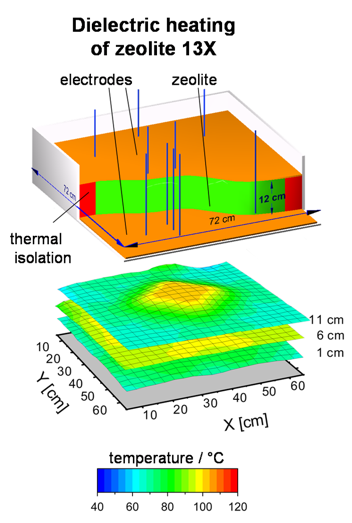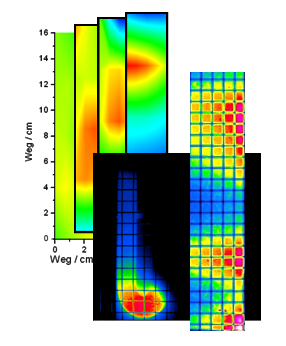Dielectric heating of adsorber materials and catalysts
Introduction
In many technical applications including air fractionation and off gas cleaning adsorber materials play an important role. In spite of the wide application range all adsorbers have in common, that subsequent to a loading phase a regeneration phase is necessary to restart the adsorption/desorption cycle. In many cases regeneration is done by heating adsorbers up to typically 200 to 400°C. Under the aspects of an optimum cost and time efficient regeneration a fast and homogenous heating of the whole packed bed is desirable. Most used are adsorber materials in form of pelletized packed bed. Due to comparatively low heat conductivities of such packed beds and low heat capacity of heating gases conventional heating technologies do not work time and energy efficient. Due to the direct energy input leading to heat formation within the volume of the adsorber, heating techniques using electromagnetic waves can overcome these physical limitations.
An analogous argumentation can be given for catalyst heating. Most noble metal catalysts (e.g. palladium or platinum) are placed on a porous support material which is acting as an adsorber. Similar to adsorbers for adsorption and desorption processes and non porous metal oxide catalysts (e.g. chrome, titanium or copper oxide) they are typically used in form of packed beds or honeycomb carriers. Both forms exhibits low heat conductivities. Thus, for catalysis, especially when used in combination with adsorption, dielectric heating using radio waves can be a suitable tool to optimise technical heating and, therefore, also chemical conversion processes.
Dielectric heating
 Dielectric heating processes are based on direct heat formation within a material induced by electromagnetic waves like microwaves or radio waves. While microwave technique is much more common and its equipment is rather cheap, radio wave heating has got some significant advantages. Radio wave heating is much more flexible in terms of materials to be heated. In the field of adsorber materials not only active carbon and silica gel but also almost all types of zeolites can be heated, rapidly and homogeneously. Furthermore, the penetration depths of radio waves are much larger than those for microwaves leading to larger homogeneous heated volumes up to cubic meter range.
Dielectric heating processes are based on direct heat formation within a material induced by electromagnetic waves like microwaves or radio waves. While microwave technique is much more common and its equipment is rather cheap, radio wave heating has got some significant advantages. Radio wave heating is much more flexible in terms of materials to be heated. In the field of adsorber materials not only active carbon and silica gel but also almost all types of zeolites can be heated, rapidly and homogeneously. Furthermore, the penetration depths of radio waves are much larger than those for microwaves leading to larger homogeneous heated volumes up to cubic meter range.
Another advantage of radio wave heating is the application of a matching network leading to a low power reflection from the load back to the generator. This possibility of energy input optimization allows transmission efficiencies from HF-power to heat of more than 80 % for many materials in laboratory and technical scale.
Selective heating
In many studies it could be shown, that depending on several conditions like electrode design, gas pressure, main diameter of the heated particles or dielectric material properties selective heating effects by radio waves can occur. These effects materialize in from of a static, selectively heated zone in a homogeneous packed bed or preferably heated zones in a multi-component pecked or the so called thermo-chromatographic pulse (TCP), a hot zone moving through a packed bed. The possibility of selective heating using radio waves opens up a wide range of new applications e.g. in chemical process engineering where more flexible and precise heating processes are in demand to comply with stricter energy efficiency requirements.

